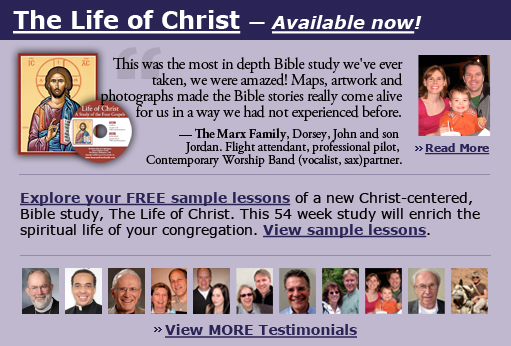
Series A
Looking In The Wrong Places
Gospel Analysis
EASTER 3A Luke 24:13-35
The following Bible study is from a larger course entitled, THE LIFE OF CHRIST: A Study in the Four Gospels. This 54 week course for the laity will be available for congregations in 2008.
Basic text for the course: SYNOPSIS OF THE FOUR GOSPELS, Kurt Aland, English Edition, P. 330-331.
The Gospel of Luke and the Resurrection
This lesson focuses on the resurrection events in the Gospel of Luke. What does Luke have to teach us about the resurrection? What is Luke’s emphasis in his resurrection stories?
Luke’s resurrection stories are:
- The Women at the Tomb (idle tale, Peter running, linen shroud)
- The Road to Emmaus story (about the two men meeting the Risen Christ)
- The Road to Emmaus report (that Jesus already appeared to Simon Peter)
- The Eleven Disciples (shows hands and feet)
- Resurrection Appearances in Acts
- Jesus appeared many times in order to “prove” his resurrection
- Jesus appeared during 40 days.
- Jesus taught that people did not to know the time of the End.
- Jesus taught that the disciples would be empowered by the Holy Spirit and would
be his witnesses in Jerusalem, Judea and the end of the earth.
- Jesus ascended into heaven at Bethany and two angels were there
- The Ascension
#352. The Women At The Tomb
Luke 24:1-12
Read Luke only. We have previously studied this. Read it. Highlight it. We notice that Matthew, Mark and Luke are parallel.
-But on the first day of the week, at early dawn, they came to the tomb, taking the spices that they had prepared.
-They found the stone rolled away from the tomb, but when they went in, they did not find the body.
-While they were perplexed about this, suddenly two men in dazzling clothes stood beside them. When we read Luke’s account of this episode, it feels like a historical event. But later in Luke’s account, we will find out that he was describing a vision that the women experienced.
-The women were terrified and bowed their faces to the ground,
-But the men said to them, "Why do you look for the living among the dead? He is not here, but has risen. Remember how he told you, while he was still in Galilee, that the Son of Man must be handed over to sinners, and be crucified, and on the third day rise again." While in Galilee, Jesus had prophecied that he would be handed over, crucified and then raised on the third day. The disciples and women did not comprehend what Jesus was saying to them. They did not comprehend that the Messiah would suffer. The concept of a suffering Messiah was way beyond their thinking. And the further truth that this suffering Messiah would be raised from the dead was “wild beyond human imagination.” In other words, the women and the disciples were not expecting the Messiah to be raised from the dead. Those words barely registered in their memory banks.
-Then they remembered his words, and returning from the tomb, they told all this to the eleven and to all the rest. When the angels spoke, they did recall that Jesus had told them these things. In fact, Jesus had told them “these things” three times in his three “passion predictions”
The women reported their experience to the disciples and all the rest. It wasn’t just the eleven disciples. There were others present as well.
-Now it was Mary Magdalene, Joanna, Mary the mother of James, and the other women with them who told this to the apostles. Only Luke. In Luke’s account, there were several women who witnessed the empty tomb. We recall that Luke is the “gospel of womanhood” and that there are several positive stories about women in the books of Luke and Acts. See Luke 8:1-3, page 107, and we hear a story about some of these same women “who provided for the disciples out of them means.” Specifically, Mary Magdalene and Joanna are mentioned in both accounts. Specifically, both accounts mention “other women.”
Uniquely, in Luke’s gospel, he emphasizes that there were a group of women who witnessed the empty tomb and heard the message of the angels. In Matthew’s gospel, we will hear the story of two women, Mary Magdalene and the “other Mary” who went to tell the disciples. But it is only in Luke’s gospel that we encounter this group of women at the empty tomb. This group of women appear to be the same women from Luke 8:1-3 who were financially supporting the disciples earlier in their ministry.
The report of these women will be important in the next story in Luke about the two men walking to Emmaus.
-But these words seemed to them an idle tale, and they did not believe them. Circle
the phrase, “idle tale.” We remember that Luke was dealing with doubts. So often in our lives of doubt and skepticism, we secretly are suspicious that the story of the resurrection of Jesus was “an idle tale, told by idiots, signifying nothing but illusions.”
-But Peter got up and ran to the tomb; stooping and looking in, he saw the linen cloths by themselves; then he went home, amazed at what had happened. There is no mention of John in this account. Peter stoops and looks in. He saw the linen clothes. Peter than went “home” but we don’t know where his home was in Jerusalem. Peter was “amazed” at what he saw and “amazed” is a better translation of the Greek word than “wondered.” Peter was amazed that the tomb was empty.
Later in this story from Luke, we will hear that “they” went to the empty tomb.
The gospel lesson for Eater 3A begins here
#355. Jesus Appears to Two on the Way to Emmaus
Luke 24:13-35
This story is unique to Luke. No other gospel accounts tell this resurrection story that occurred on the road to Emmaus.
-Now on that same day two of them were going to a village called Emmaus, about seven miles from Jerusalem, The disciples journey to Emmaus. This village has not yet been identified by archeological research. “That same day” is the first day of the week, which came to be known as the Lord’s Day. At the end of the story, we will discover that these two disciples were not part of the eleven disciples.
-And talking with each other about all these things that had happened.
-While they were talking and discussing, Jesus himself came near and went with them, but their eyes were kept from recognizing him. Like Mary Magdalene at the tomb and the seven disciples on the Sea of Tiberias, these two disciples did not recognize the identity of Jesus. It was as if God has kept their eyes from recognizing the true identify of Jesus…for the moment.
-And he said to them, ‘What are you discussing with each other while you walk along?’ It almost is as if Jesus was “baiting” them.
-They stood still, looking sad. A person can visualize them standing still on a quiet dusty road, looking sad and perplexed. To the reader, it feels like a moment of silence.
-Then one of them, whose name was Cleopas, answered him, We are not sure of the identity of Cleopas. According to Eusebius in the fourth century, Cleopas was Jesus' uncle, the brother of Joseph. But that information is three centuries after the date of the resurrection.
-‘Are you the only stranger in Jerusalem who does not know the things that have taken place there in these days?’ Everybody in Jerusalem was talking about the crucifixion and death of Jesus.
-He asked them, ‘What things?’ Jesus asks the two disciples to report what happened during the past few days.
-They replied, ‘The things about Jesus of Nazareth, who was a prophet mighty in deed and word before God and all the people, These two men thought of Jesus as a great prophet who was mighty in both word and deed. Jesus had been the great teacher and rabbi. He had also worked many miracles.
-And how our chief priests and leaders handed him over to be condemned to death and crucified him. It has been clear: the chief priests and religious leaders were the culprits behind the crucifixion. But the two men acknowledge that these were “our” leaders.
-But we had hoped that he was the one to redeem Israel. Like so many people, these two men had hoped that Jesus would have been a political messiah like King David from a thousand years before and would have freed their nation from the oppression of Roman rule.
-Yes, and besides all this, it is now the third day since these things took place. Underline the phrase, “the third day.” Action is ready to break loose.
-Moreover, some women of our group astounded us. Yes, this whole event was astounding, especially for the women who had experienced the empty tomb and two men dressed in dazzling white (a vision of angels.)
-They were at the tomb early this morning, and when they did not find his body there, This is consistent with the other Biblical reports: Jesus’ body was not in the tomb.
-They came back and told us that they had indeed seen a vision of angels who said that he was alive. The women reported what they had seen: a vision of angels. They believed that Jesus was no longer dead but alive. In Luke’s next story, we will discover that the Risen Christ was not a vision, whereas the women saw a vision. In Luke’s account, he will underscore that the body of Jesus was not a vision, that Jesus’ body had flesh and bones and wounds from the cross. Also, earlier in this chapter, when reading Luke’s account of the empty tomb, it felt as if Luke was reporting a historical occurrence of two angels. But here in this verse, we discover that the presence of angels was a visionary experience rather than a historical appearance.
-Some of those who were with us went to the tomb and found it just as the women had said; but they did not see him.’ That is, Peter and John had run to the tomb (according to the Gospel of John) but they (Peter and John) did not see the Risen Christ but only the empty tomb. Luke reports that “they” did not see him. The “they” suggests plural; that more than Peter ran to the empty tomb.
-Then he said to them, ‘Oh, how foolish you are, and how slow of heart to believe all that the prophets have declared! This has been a problem for disciples in all centuries. That is, there are many of us disciples who are slow of heart to believe in the resurrection. We are slow of heart to believe the prophecies of the Old Testament about Jesus. If you are slow of heart to believe in the resurrection of Jesus, be comforted that the first Christians were also slow to believe that Jesus had been raised from the dead by the powers of God.
-Was it not necessary that the Messiah should suffer these things and then enter into his glory?’ The word, “necessary,” is an important word in the New Testament. Underlying that word is the Greek word, “dei.” It is necessary. It is part of the divine plan of God, the eternal destiny, that it was necessary for Jesus to suffer on the cross. It was also part of the divine plan that he should enter into glory. It was not only the crucifixion but also the resurrection that was part of God’s grand design for Jesus’ life here on earth.
-Then beginning with Moses and all the prophets, he interpreted to them the things about himself in all the Scriptures. The Scriptures are the Old Testament (the Law and the Prophets.)The New Testament had not yet been written. Jesus took the Old Testament and demonstrated that the prophecies of the Old Testament referred to Jesus himself. On the road to Emmaus, Jesus also opened up the Scriptures and interpreted the Scriptures to them. The same emphasis process happened on the Sea of Tiberias in John 21. Jesus opened up the Scriptures so that the disciples could understand what was happening. Three times in this short text, we are going to hear about Christ “opening the Scriptures” so that the disciples can understand. That is what this class is about. That is what all Bible classes are about.
In the Word. Christians through the centuries have always focused on the Word of God, the Bible and the person of Jesus Christ, as the place to find God. In a moment, the two men who had been walking with Jesus will say, “Did not our hearts burn within when he opened up to us the Scriptures?”
Sometimes, we seek God in the wrong places e.g. in the pastors, the programs, the paraphernalia of the church. When we seek God’s presence in the wrong places, we often become disillusioned and disappointed. We need to find God where God wants to be found and often that is in the study of God’s Word.
-As they came near the village to which they were going, he walked ahead as if he were going on. But they urged him strongly, saying, ‘Stay with us, because it is almost evening and the day is now nearly over.’ So he went in to stay with them. These two disciples still did not recognize Jesus. They urged Jesus to stay with them for the night. Jesus did.
-When he was at the table with them, he took bread, blessed and broke it, and gave it to them. Jesus was eating a meal with these two men. While Jesus was with them, he spoke words that sound like the “Word of Institution” from the Eucharist. It was in the breaking of the bread that Jesus revealed himself.
http://perso.wanadoo.fr/maurice.lamouroux/image/lc24a/index.htm
Carvaggio, The Road To Emmaus
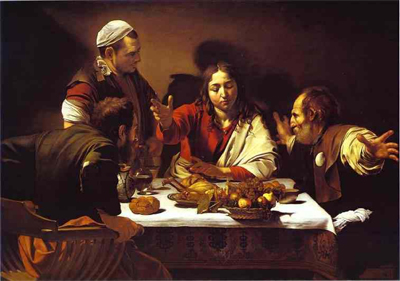
Rembrandt, The Road to Emmaus
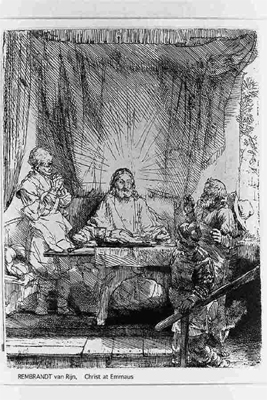
-Then their eyes were opened, and they recognized him; and he vanished from their sight. Christ revealed himself to them in the breaking of the bread. The two disciples recognized Christ in the breaking of the bread. Many Christians interpret this to mean Holy Communion today.
-They said to each other, ‘Were not our hearts burning within us while he was talking to us on the road, while he was opening the Scriptures to us?’ This is the key line of this resurrection story. Underline it. Highlight it. Jesus opened the Scriptures to the pair of disciples and their hearts burned with interest as Jesus taught them. This theme, “opened the Scriptures for us,” will occur in the next story about Jesus’ resurrection appearance to his disciples.
Many churches define themselves as “Word and Sacrament” churches. That is, Christ reveals himself most clearly and significantly in the Word and in the Sacraments.
-That same hour they got up and returned to Jerusalem; and they found the eleven and their companions gathered together. It seems as if the day was almost over and night was drawing nigh, but this pair of disciples got up and headed for Jerusalem to tell the other disciples what happened. They found the eleven disciples. That means, the two disciples were not part of the original group of “the twelve.”
-They were saying, ‘The Lord has risen indeed, and he has appeared to Simon!’ “The Lord has risen. He has appeared to Simon.” We would think that the narrative of Jesus’ resurrection appearance to Simon Peter would certainly have been recorded somewhere in the gospels, but surprisingly it is not. We think that the story of “Peter seeing the Risen Christ” would have been reported especially in the Gospel of Mark which was an eyewitness account of Simon Peter to John Mark before Peter was killed in Rome. Peter certainly would have told us about his own resurrection encounter with Jesus, but that story does not occur in the Gospel of Mark.
Why did Peter’s story of his meeting with the Risen Christ not appear in the Gospel of Mark? This story probably did in the original version of that gospel, but it seems that the original ending of the Gospel of Mark has been lost.
-Then they told what had happened on the road, and how he had been made known to them in the breaking of the bread. For many of us interpreters of the New Testament, this is a clear reference to Holy Communion. Christ is to be found in the Sacrament of Holy Communion.
In the Word and in the Sacrament. This story about the two men on the road to Emmaus is telling us where we can find a personal, in depth, communication with God/Jesus. In the Word. In the Sacrament. In the breaking of the bread.
The Gospel lesson for Easter 3A ends here
The gospel lesson for Eater Eve continues here
#356. Jesus Appears To His Disciples
Luke 24:36-43
-While they were talking about this, Jesus himself stood among them and said to them, ‘Peace be with you.’ Consistently and persistently, Jesus begins his resurrection appearances with his reassuring words, “Peace be with you.”
-They were startled and terrified, and thought that they were seeing a ghost. The disciples were spooked by what they saw. The disciples thought that they were seeing a ghost or an apparition. Luke is working with the doubt that many people have: that the Risen Christ was a ghost, an apparition, or a fantasy of the mind.
-He said to them, ‘Why are you frightened, People are afraid when they see the Risen Christ. They are not expecting this event at all.
-And why do doubts arise in your hearts? This is the question for all generations, including our scientifically minded generation. “Why do doubts arise in your hearts?” We all have doubts and some of us have more doubts about the resurrection than others. The inner core of his most trusted disciples had doubts rising in their heads and hearts. In our previous lesson on the resurrection appearances from the Gospel of John, we learned that there were seven “doubting stories” within the resurrection narratives. The theme of “doubt” permeates the resurrection stories, and Luke is dealing with such normal doubts that are found in the hearts and minds of true disciples.
-Look at my hands and my feet; see that it is I myself. Touch me and see; for a ghost does not have flesh and bones as you see that I have.’ Jesus wanted to demonstrate that he was not a ghost. The women at the tomb may have seen a vision of the angels, but this event was no vision or ghostly apparition. The only way to demonstrate that his body was not a ghostly or a vision was to convince the disciples to touch his wounds and body.
Today, Luke wants to convince us his readers that the Risen Christ is more than an “idle tale.” It is as if Luke sensed that in coming generations that many people would reject Christ because they thought of his resurrection, eternal life, and life after death as all part of “an idle tale” and foolish fantasies.
-And when he had said this, he showed them his hands and his feet. Jesus was very direct. He showed his disciples his hands and feet. In the Book of Acts, Luke will record, “After his suffering he (Jesus) presented himself alive to them by many convincing proofs.” Jesus was presenting his resurrected body to his disciples in such a way that they disciples were convinced that this was indeed a physical body with flesh and bones. We notice that there is no story of “doubting Thomas” in Luke’s Gospel, but we heard that Jesus addressed the doubts of his disciples by showing them his wounded hands and feet. Luke wanted to convince Theophilus (to whom the book was originally written) and us that Jesus of Nazareth was raised from the dead and that his resurrection was not a vision, nor an idle tale, nor a hallucination of the mind.
-While in their joy they were disbelieving and still wondering, Even when Jesus was revealing himself, the disciples still were not sure. They were still doubting and still wondering what was going on. They thought that they were perhaps seeing a ghost, a hallucination, or a mental illusion like a mirage or dream. But they were still joyful, in the same moment, that Christ had been raised from the dead. We remember that the Gospel of Luke has several unique refers to “joy.” When we believe in the resurrection of Jesus and his gift of eternal life, there is a deep and abiding joy that lives deep within our hearts.
-He said to them, ‘Have you anything here to eat?’ They gave him a piece of broiled fish, and he took it and ate in their presence. Jesus ate a piece of fish to show that he was not a ghost, a hallucination, or a dream image. Luke wants to “prove” that Christ was risen from the dead.
In Luke, there is no parallel story to doubting Thomas.
#365. Ending Of Luke: Jesus' Lat WOrds and Ascension
Luke 24:44-53
-Then he said to them, ‘These are my words that I spoke to you while I was still with you—that everything written about me in the law of Moses, the prophets, and the psalms must be fulfilled.’ Jesus’ life, death and resurrection were a fulfillment of Old Testament prophecies. Notice the three parts of the Old Testament: the Law, Prophets, and Writings (Psalms).
-Then he opened their minds to understand the Scriptures, This is the key. This is the third time in a few short verses that we clearly hear that Jesus “opened their minds to understand the Scriptures.” The Risen Christ opened their minds and similarly today, the Risen Christ opens our minds so that we understand the Scriptures and comprehend what they teach about Christ. This is the same theme that Jesus echoed on the road to Emmaus. This is the same theme that he echoed on the Sea of Tiberias. The Scriptures are the Old Testament, that the Old Testament prophecied that the Messiah was both to suffer and be raised from the dead.
-And he said to them, ‘Thus it is written, that the Messiah is to suffer and to rise from the dead on the third day, and that repentance and forgiveness of sins is to be proclaimed in his name to all nations, beginning from Jerusalem. This is a comprehensive summary of the Christian faith. The Messiah was to suffer e.g. the stories about Good Friday. The Messiah was to be raised from the dead on the third day e.g. the stories about Easter. The Messianic people are to preach repentance and forgiveness to all the nations of the world, beginning in Jerusalem. To preach forgiveness without repentance is “cheap forgiveness.”
-You are witnesses of these things. The disciples are the first hand witnesses to the Risen Christ. These disciples have seen with their own eyes and touched with their own hands the body of the Risen Christ. His body is not an illusion, a fantasy, a hallucination.
-And see, I am sending upon you what my Father promised; so stay here in the city until you have been clothed with power from on high.’ What has the Father promised to send? The Holy Spirit. This is a clear reference to the Book of Acts and the second of Luke’s books in the New Testament. That Holy Spirit is the power from on high.
The gospel lesson for Easter ends here:
-Then he led them out as far as Bethany, and, lifting up his hands, he blessed them. We recall that the Ascension occurred at Bethany which was two miles outside of Jerusalem. We have seen the map several times with the location of Bethany on the Mount of Olives.
-While he was blessing them, he withdrew from them and was carried up into heaven. This is the Ascension. When the time was right and ripe, Jesus came down to earth from heaven and became a human being here on earth. He loved, lived, taught, did miracles. He was persecuted, killed and raised from the dead. Then, when the time was right, Jesus returned to heaven from where he originally came. Jesus went back to his former existence with God the Creator.
-And they worshiped him, and returned to Jerusalem with great joy; In Luke’s Ascension story, the disciples worshipped him. In Matthew’s Ascension story, we will hear that some doubted even at that final moment. At the heart of all Christian experience is the movement towards worshipping Jesus Christ as Lord.
They returned to Jerusalem with great joy. When you worship God and know that you are worshipping the true, Almighty God from the Father, who is simply our heavenly Father who loves us and we are God’s very own; your hearts are filled with great joy.
-And they were continually in the temple blessing God. We remember the temple from our hearing all of the stories of Jesus teaching in that temple. The disciples were in that temple, praising God and waiting for the moment when they would be “clothed with power from on high.”
Ninian, The Ascension
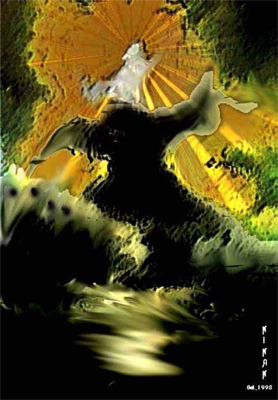
African, Mafa, The Ascension
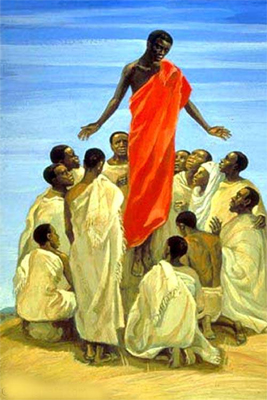
Rembrandt, The Ascension
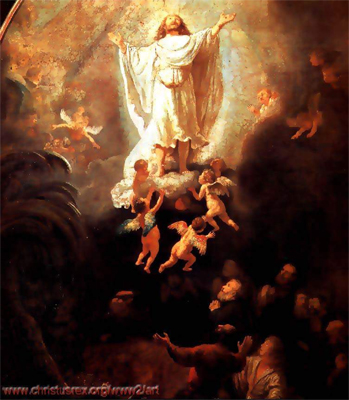
Fractal, American, The Ascension

Resurrection Stories In The Book Of Acts (Luke)
http://www.biblegateway.com/cgi-bin/web
commentary?language=english&vers
ion=niv&book=luke&chapter=24
“Though Luke is concluding his Gospel, the real story is just beginning. Ahead is the disciples' empowerment through the bestowal of the Spirit so they can carry out their call on behalf of God. Beyond that is the mission to proclaim to the world what they have experienced and understood. Jesus had ministered to them to prepare them for this time. Now it is nearly time to go. Training camp is just about over; a long season of ministry lies ahead.” (Underlining mine)
Acts 1:1-10
-In the first book, Theophilus, Luke wrote two books which comprise forty percent of the New Testament: Luke and Acts. Luke was his first book; Acts is his second book. Luke was a physician and traveling companion of the Apostle Paul. Theophilus was a Roman official. His name means: theo = God; philus = love. Theophilus was a lover of God.
- I wrote about all that Jesus did and taught from the beginning until the day when he was taken up to heaven, In his first book, Luke told the story of Jesus from the very beginning of infancy, from the unusual births of John the Baptist and Jesus, through the very last event of Jesus’ life, the Ascension and being taken up to heaven.
-After giving instructions through the Holy Spirit to the apostles whom he had chosen. Jesus had given instruction the apostles to remain in Jerusalem. Jesus himself gave instructions through the Holy Spirit. We know that the Holy Spirit was upon Jesus, especially after his baptism and Jesus gave Spirit filled instructions to his disciples.
-After his suffering he presented himself alive to them by many convincing proofs, After Good Friday and its suffering, Jesus rose from the dead and presented himself alive to the disciples with many convincing proofs. Luke, the physician, wanted to confront the normal doubts which he anticipated would be in the mind of Theophilus and every other person through the centuries. Jesus presented himself alive by many convincing proofs. Knowing that we can never “prove” the resurrection of Jesus, Luke is offering us many convincing proofsand arguments for his resurrection.
-Appearing to them during forty days and speaking about the kingdom of God. We hear a new fact: Jesus appeared to the disciples for forty days. Forty is a symbolic number in the New Testament: Jesus was tested for forty days and nights in the wilderness. In the Old Testament, we remember that Noah was on his ark for forty days and nights. We remember that the Jews were in the wilderness for forty years. We also remember that a generation was forty years.
-While staying with them, he ordered them not to leave Jerusalem, but to wait there for the promise of the Father.
-‘This,’ he said, ‘is what you have heard from me; for John baptized with water, but you will be baptized with the Holy Spirit not many days from now.’ Jesus is getting to the heart of the issue: The disciples of every generation and culture will be baptized with the power of the Holy Spirit. Jesus wants us and all Christians to be baptized with the Holy Spirit. We recall that Luke’s Gospel and Acts are filled with references to the indwelling and power of the Holy Spirit. Sometimes, the Book of Acts has been labeled the Book of the Spirit.
-So when they had come together, they asked him, ‘Lord, is this the time when you will restore the kingdom to Israel?’ Even after the resurrection, the disciples were still thinking in political terms, that the Risen Christ would restore the nation of Israel to its former grandeur.
-He replied, ‘It is not for you to know the times or periods that the Father has set by his own authority. No one can figure out the time of the End, the Second Coming, or even the timing of our own death. Earlier in our studies, we discovered that even Jesus did not know the timing of the End of history but only God the Father did.
-But you will receive power when the Holy Spirit has come upon you; and you will be my witnesses in Jerusalem, in all Judea and Samaria, and to the ends of the earth.’ These key words are some of the most important words in the New Testament: You shall receive power when the Holy Spirit comes upon you. This is the “big commissioning” of the Church, the purpose of the Church, the power behind the Church that energizes the Church. Jesus tells us that we are to be filled with the power of the Holy Spirit and are to witnesses to him throughout the entire world.
These were the last words of Jesus before he departed to heaven. Last words are often enormously important words. These words from Acts 1:8 are enormously important. These are Jesus’ final words to us.
There are three times that the word, “you,” is in this passage. Near two of the three occurrences of the word, “you,” write in your own personal name. My personal first name is Edward. So for me the verse reads like this: “But you, Edward, will receive power when the Holy Spirit has come upon you and you, Edward, will be my witness in Jerusalem, Judea, Samaria, and to the ends of the earth, including Des Moines, Washington.” After “ends of the earth,” add you own special geographic location.
The last words of Jesus in the Gospel of Matthew are: “Go therefore and make disciples of all nations, baptizing them in the name of the Father and of the Son and of the Holy Spirit, teaching them to observe all things that I have commanded you. Lo, I am with you always, until the end of the age.” The last words of Jesus in the gospels of Luke and Matthew express the same sentiments: “Go and make disciples of Jesus Christ.”
-When he had said this, as they were watching, he was lifted up, and a cloud took him out of their sight. As the disciples were watching, Jesus was lifted up into heaven and out of their sight.
-While he was going and they were gazing up toward heaven, suddenly two men in white robes stood by them. As Jesus was ascending, and the disciples’ necks were tilted upwards and they were gazing up to heaven, suddenly two men stood by them. These two men we had met earlier in story about the empty tomb. In the story of the two men in the empty tomb, it felt as if this story were a historical account, but we later heard from Luke that the angels were part of a vision. This story feels like a historical account but it may be similar to the story of the two angels in the tomb: a vision.
-They said, ‘Men of Galilee, why do you stand looking up toward heaven? This Jesus, who has been taken up from you into heaven, will come in the same way as you saw him go into heaven.’ The two angels prophecied the Second Coming of Christ. Jesus will return. Jesus will come back to earth again at the End of Time.
-Then they returned to Jerusalem from the mount called Olivet, which is near Jerusalem, a Sabbath day’s journey away. From earlier studies, we remember the location of Mount Olivet, the fields of olive trees, the location of the Garden of Gethsemane, and the village of Bethany. This ends the story of the resurrection/ascension in the Gospel of Luke.


 Back
to Top Back
to Top |






